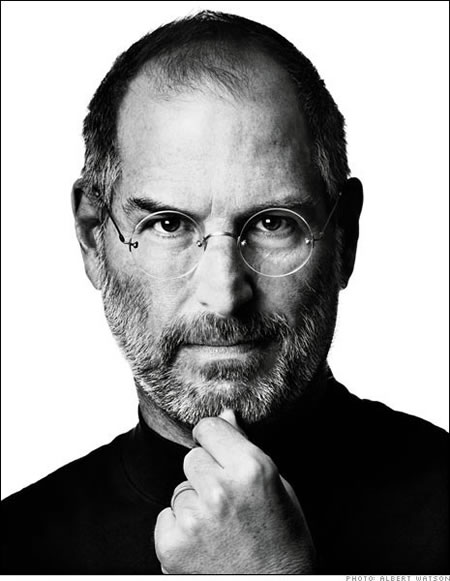
Exemplars of Apple Messaging and Brand Product Events: Theatricality and entertainment marketing strategy in the presentation of ideas.
Being one whose livelihood is wholly built on the premise of relevant content, delivery and entertainment — the concept of the power of the pitch — the presentation, the keynote is one of careful orchestration and craft; it’s an art. Like the premise of motion picture work, our approach is based on story-boarding presentations — literally the boarded drawings of stories — that string out the cinematic structuring of content. For me, actually in the alignment of thinking and organization of ideas — how to present material so they can be grasped — I do just that: thumb-nail sized sketches of formats, notes of content, presentations of strategy, substrate and illustrative content — my (or others) photography — all sequenced in a manner of comprehension.
In brand presentation — at shelf, in animation, in hand, or online — enthusiasm, or glee, is a component of the happiness of the modeling of depiction. Happiness. Excitement. Insane marvelment. Igniting wonderment. Awe. Thunder-striking your audience. Our mix of exploring the concept of visualizing enthusiasm might be found here, in our reels of motion based content. Our work is always about embracement of the idea — to work on a business, usually, we love that brand. Not always, but most of the time.
Brand love — really celebrating the ideal of a brand, its premise and the attitude that it stands for — is about brand passion; it is being sufficiently enmeshed in the approach and construct of the character of a brand positioning, that it can be articulated celebratively.
Girvin thinking about Steve Jobs.
In the early days of working with Steve Jobs — being exposed to him on the opening examinations of the Macintosh platform — the “mouse cursor”, how does it work, especially for someone that draws? The connection for me with Steve was Stanford — and hanging out with a string of San Francisco designers — Michael Manwaring, Michael Vanderbyl, and Michael Cronan. We all went to the Stanford Conference on Design together. Lessons learned, beer swilled, stories told — and a bond with the Michaels of San Francisco. But during that time I’d met Steve because he presented there — and I went to him, after the talk, and we talked. Our conversation ranged back to Reed, where I spent time as a kind of interloper on campus, rambling around in my old red 1959 Dodge Pickup, “Ruby”, staying with art historian, theorist and mystic calligrapher, Lloyd Reynolds — Professor of Art History and Literature at Reed College. I was struck by the compositing of content that he offered — he mixed things up; and he brought things together in ways that I’d never experienced before. He did the same thing for Steve Jobs — there was inspiration; and the recollection of those times was unforgettable.
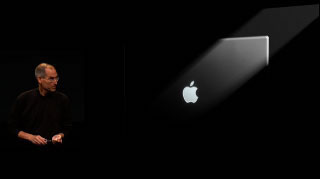
Steve Jobs, forms of inspiration
Steve Jobs, in the graduation keynotes and pronouncements, has referenced that. And in exploring other work, down the line, I found that the connection to the notions of the illustration of idea(s) — simple, elegant, restrained, was a resonant chord in the early years, and surely one that keeps the messaging in play now.
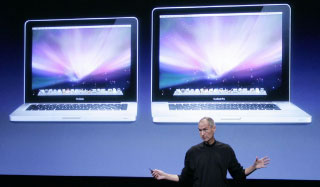
In a note from a colleague, about that selfsame history — and as well, the concept of killer presentations, there are things that I learned then that I’m still experimenting with. Here, now: “7 Lessons from a Marketing Genius” was created by Carmine Gallo, author of The Presentation Secrets of Steve Jobs: How to Be Insanely Great in Front of Any Audience. Apple CEO Jobs is considered one of the greatest marketers in corporate history. For more than three decades, he has delivered legendary keynote presentations, raised product launches to an art form and successfully communicated the benefits of Apple products to millions of customers. Whether you’re in sales, marketing, advertising or public relations, Steve Jobs has something to teach you about telling your brand story.
Being insanely great. I’d offer that, in front of all this, having a key message that relates to passion is crucial. And having a message that is distinctively yours, is another positioning differentiator. So, in being “different”, being insanely great is truly recognizable.
And Steve Jobs bleeds passion — I’m certain that his drive might be something that has, in a way, afflicted his health. Push too hard, year after year, for insane greatness and there might be outcomes. But for me, that idea of insane greatness is a true binder to the spirit of Steve Jobs. It’s where he lives — that distant plain where extraordinary dreams, visions and enterprises are built. So, after this opening of powerful — personally owned and positioning — how do incredible presentations get built?
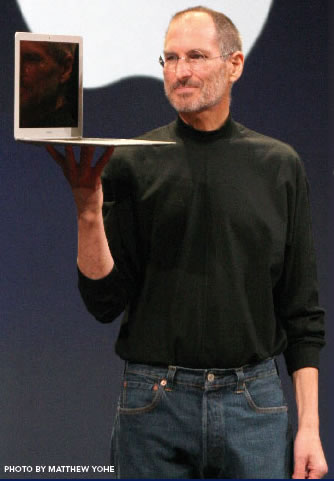
The power presentation, then:
1. Plan simple: analog. Jobs draws his presentations out with pen and paper. No digital, just straight from the heart to the fist and fingers. Mind speed.
2. Plan messaging as a sequence of the best idea(l)s. Be consistent in simple messaging that works across all platforms of communications: presentations, Web sites, press releases, advertisements, even — in Jobs’ keynotes, the banners that unfurl after the talk.
3. Twitterize messaging. Whether planned or not, Jobs offers a structure for messaging — headline, or descriptive phrasing, for every product, that can be tweeted, or fit in a twitter-length posting.
4. Speak to tweets. Twitter friendly headlines will get out on the Web fast; spread the word in a manner that instantaneous transmission is fluent. “The world’s thinnest notebook.” Simple, and inherently “get-able”.
5. Be mythic. We’ve talked a lot about the mythic dimensionality of brand storytelling; there are thematic components that speak to the character of the hero, and the antagonist. You, the presenter, are the raconteur that can tell the story in a legendary light. And legends, by legacy, are never forgotten.
6. Setting the battleground of the telling. Who are the players in this story, combative or otherwise? Little Apple. Big IBM. “IBM wants it all”, was the rallying cry of Steve — 25 years back, 1984 — and that call still goes on. And on. Create the circle. We’ve referenced the cultic character of Apple evangelism. We live there, too.
7. The power of three. Girvin believes that any brand has three levels of messaging — the identity, the opening tagline or signature, the positioning content. Steve Jobs, too, builds his presentations on the presumption of three tiers of message — the human brand can gather three main ideas. After that, it’s forgotten. Present: three parts.
8. Triadic messaging: After months of illness, and fears about health — Steve’s opening return was: i. iPods. iTunes. iPhone. Rather than belaboring the notion of health and the character of his condition — he moved right to the heart of the offering. In threes…
9. Be simple, live simple. Apple’s positioning seems to look like light — it’s clean and clear; everything Apple has that vocabulary of clarity. And they own it. Jonathan Ive, the lead creative director and industrial design product strategist suggests that Apple eliminates clutter. Practice what you preach.
10. Content. The idea of imagery as a compelling point of connection for memory is proven. People read very little, in the form of advertising; and as it’s been pointed out, people really don’t care about advertising. So — pictures speak millions of words.
11. The epiphanic moment. You’re always hoping that some attribute of your presentation strikes magic flint in the imagination of your audience. I’ve had audience members say, in review — “I’m not sure if I know what he was talking about, but it was sure beautiful”. Rightly said. Sometimes the content itself might be complex and hard to understand — but I’m really only looking for the story — what’s the story, who cares about it, and how quickly can it be grasped. Holy smokes — Jobs builds water-cooler stories that are so cool and compelling that they traverse story lines. All of them are completely scripted.
12. Be magic. The idea of revealing something remarkable can be a turn of phrase, an incredible image, a marvelous story. Like Jobs’ revealing a MacBookAir at Macworld 2008 by pulling it from an inter-office envelope. That’s entertainment. Unforgettable. And legends spread.
13. The dreamer is the whole dream. People follow others because they believe in the dream — it might not be their dream, or electrify their vision personally, but they relate to the exemplification. And in seeing a dream, it might make their own dreaming a much bigger and more resonantly powerful personal expression and experience. Jobs has expressed his interest in putting a “dent in the universe” — the leading cause of evangelism might be in the willingness to lead others into new experiences, as part of the personal quest to get there, themselves. “Go with me, follow — and you will walk in my shoes, see what I see, and we’ll trade magic.”
14. What’s the story and who cares about it? Who’s telling it? If the telling is inspirational –something that reaches to a higher calling or purpose — it will be a gesture that is tugging at the psychic strings of the audience in marketing community. Steve said – – “in our own small way we’re going to make the world a better place.” The concept of a newly inventive treatment of a music playing device was inspirationally lofted to a higher level of innovation. You’ve got to believe it, of course.
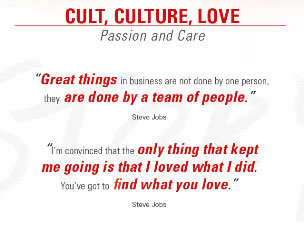
Passion, enthusiasm — these are about two things. Passion is from the Latin pati for “pain”. To be compassionate is feeling — living in — that sense of pain. But that notion of pain might be merely about experience — the complexity of living. Enthusiasm is derived from the Greek, en theos — “the indwelling of God” — and it relates to the heart of inspiration — the “spirit – in”.
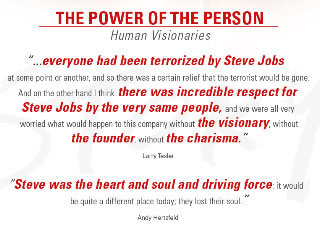
Great presentations are entertaining — but hold to the etymon of entertain. Latin inter + tenere: “to share, to mutually hold”. The embracement of fabulous presentations is about that — a reach that extends to the audiences a sense of holding.
Mutual holding.
Brand love.
tsg
….
Brands | love | humans:
http://blog.girvin.com/?p=3035
the reels: http://www.youtube.com/user/GIRVIN888
girvin blogs:
http://blog.girvin.com/
https://tim.girvin.com/index.php
girvin profiles and communities:
TED: http://www.ted.com/index.php/profiles/view/id/825
Behance: http://www.behance.net/GIRVIN-Branding
Business Profiles: http://bit.ly/MtCTK
Flickr: http://www.flickr.com/photos/tgirvin/
Google: http://www.google.com/profiles/timgirvin
LinkedIn: http://www.linkedin.com/in/timgirvin
Facebook: http://www.facebook.com/people/Tim-Girvin/644114347